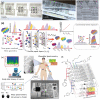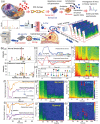Ultra-Fast Portable and Wearable Sensing Design for Continuous and Wide-Spectrum Molecular Analysis and Diagnostics
- PMID: 36266981
- PMCID: PMC9731699
- DOI: 10.1002/advs.202203693
Ultra-Fast Portable and Wearable Sensing Design for Continuous and Wide-Spectrum Molecular Analysis and Diagnostics
Abstract
The design and characterization of spatiotemporal nano-/micro-structural arrangement that enable real-time and wide-spectrum molecular analysis is reported and demonestrated in new horizons of biomedical applications, such as wearable-spectrometry, ultra-fast and onsite biopsy-decision-making for intraoperative surgical oncology, chiral-drug identification, etc. The spatiotemporal sesning arrangement is achieved by scalable, binder-free, functionalized hybrid spin-sensitive (<↑| or <↓|) graphene-ink printed sensing layers on free-standing films made of porous, fibrous, and naturally helical cellulose networks in hierarchically stacked geometrical configuration (HSGC). The HSGC operates according to a time-space-resolved architecture that modulate the mass-transfer rate for separation, eluation and detection of each individual compound within a mixture of the like, hereby providing a mass spectrogram. The HSGC could be used for a wide range of applictions, including fast and real-time spectrogram generator of volatile organic compounds during liquid-biopsy, without the need of any immunochemistry-staining and complex power-hungry cryogenic machines; and wearable spectrometry that provide spectral signature of molecular profiles emiited from skin in the course of various dietry conditions.
Keywords: breast cancer; chiral molecules; hierarchical electronics; molecular analysis; sensors; spectromerty; volatile organic compound; wearable devices.
© 2022 The Authors. Advanced Science published by Wiley-VCH GmbH.
Conflict of interest statement
The authors declare no conflict of interest.
Figures





References
-
- Richards D., Morren J. A., Pioro E. P., J. Neurol. Sci. 2020, 417, 117054. - PubMed
-
- Jensen A. R., Mainz J., Overgaard J., Acta Oncol. 2002, 41, 147. - PubMed
-
- Nguyen V. Q., Jiang D., Hoffman S. N., Guntaka S., Mays J. L., Wang A., Gomes J., Sorrentino D., Inflammatory Bowel Dis. 2017, 23,1825. - PubMed
-
- Mohammed K. I., Zaidan A. A., Zaidan B. B., Albahri O. S., Alsalem M. A., Albahri A. S., Hadim A., Hashim M., J. Med. Syst. 2019, 43, 223. - PubMed
Publication types
MeSH terms
Grants and funding
LinkOut - more resources
Full Text Sources
